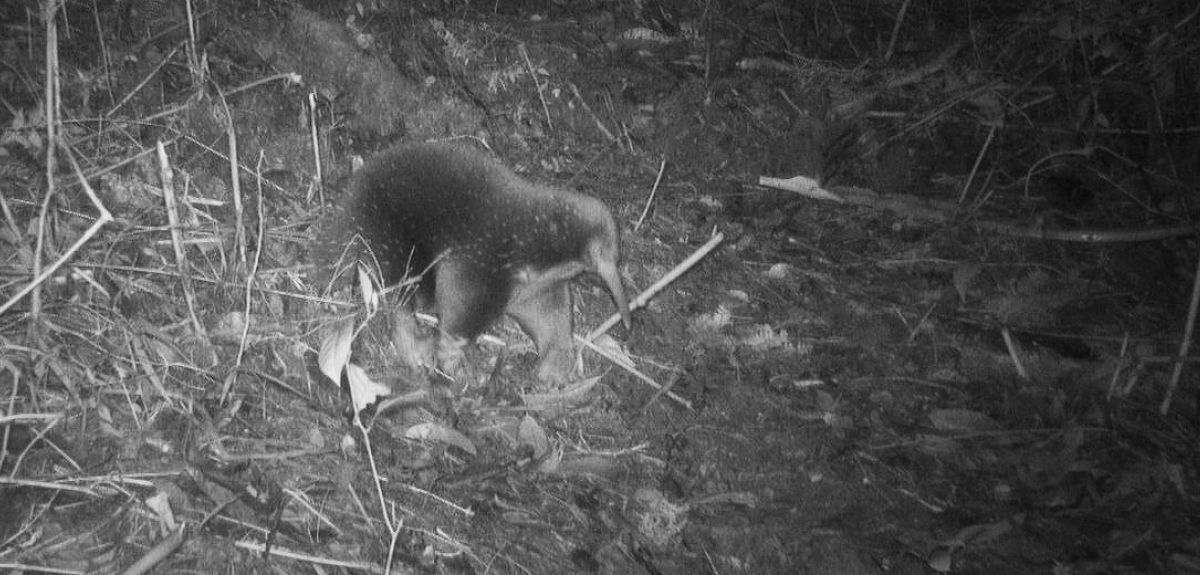
Found at last: bizarre, egg-laying mammal finally rediscovered after 60 years
More than sixty years after it was last recorded, an expedition team has rediscovered an iconic, egg-laying mammal in one of the most unexplored regions of the world. Attenborough's long-beaked echidna, named after famed broadcaster Sir David Attenborough, was captured for the first time in photos and video footage using remote trail cameras set up in the Cyclops Mountains of Indonesia's Papua Province.
Alongside the echidna's rediscovery, the expedition – a partnership between the University of Oxford, Indonesian NGO Yayasan Pelayanan Papua Nenda (YAPPENDA), Cenderawasih University (UNCEN), Papua BBKSDA, and the National Research and Innovation Agency of Indonesia (BRIN), Re:Wild – made many other remarkable finds. These included Mayr's honeyeater, a bird lost to science since 2008; an entirely new genus of tree-dwelling shrimp; countless new species of insects; and a previously unknown cave system. This was despite the difficulties posed by extremely inhospitable terrain, including venomous animals, blood-sucking leeches, malaria, earthquakes, and exhausting heat.
Attenborough's long-beaked echidna has the spines of a hedgehog, the snout of an anteater, and the feet of a mole. Because of its hybrid appearance, it shares its name with a creature of Greek mythology that is half human, half serpent. The reason it appears so unlike other mammals is because it is a member of the monotremes – an egg-laying group that separated from the rest of the mammal tree-of-life about 200 million years ago.
Dr James Kempton, Department of Biology, University of Oxford
One of the world's most unusual mammals finally caught on film
Recorded by science only once in 1961, Attenborough's long-beaked echidna is a monotreme: an evolutionarily distinct group of egg-laying mammals that includes the platypus. This echidna species is so special because it is one of only five remaining species of monotremes, the sole guardians of this remarkable branch of the tree of life. Echidnas are notoriously difficult to find since they are nocturnal, live in burrows, and tend to be very shy. Attenborough's long-beaked echidna has never been recorded anywhere outside the Cyclops Mountains, and is currently classified as Critically Endangered on the IUCN Red List of Threatened Species
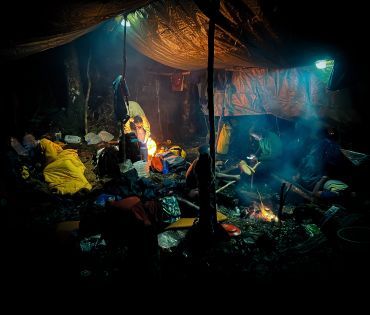 One of the expedition’s temporary campsites on the northern slopes of the Cyclops Mountains. Credit: Expedition Cyclops.
One of the expedition’s temporary campsites on the northern slopes of the Cyclops Mountains. Credit: Expedition Cyclops.Dr James Kempton (Department of Biology, University of Oxford), said: ‘The discovery is the result of a lot of hard work and over three and a half years of planning. A key reason why we succeeded is because, with the help of YAPPENDA, we have spent years building a relationship with the community of Yongsu Sapari, a village on the north coast of the Cyclops Mountains. The trust between us was the bedrock of our success because they shared with us the knowledge to navigate these treacherous mountains, and even allowed us to research on lands that have never before felt the tread of human feet.’
A treasure trove of discoveries
Alongside searching for the echidna, the expedition carried out the first comprehensive assessment of invertebrate, reptile, amphibian, and mammal life in the Cyclops Mountains. With the support of local guides in the expedition team, the scientists were able to create makeshift labs in the heart of the jungle with benches and desks made from forest branches and vines.
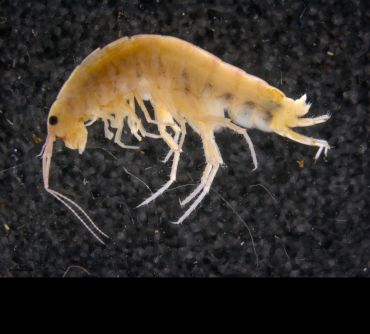 A new species of terrestrial shrimp, found in the soil and in the trees of the Cyclops Mountains. Credit: Expedition Cyclops.
A new species of terrestrial shrimp, found in the soil and in the trees of the Cyclops Mountains. Credit: Expedition Cyclops.An extraordinary finding was an entirely new genus of ground and tree-dwelling shrimp. ‘We were quite shocked to discover this shrimp in the heart of the forest, because it is a remarkable departure from the typical seaside habitat for these animals,’ said Dr Leonidas-Romanos Davranoglou (a Leverhulme Trust Postdoctoral Fellow at the Oxford University Museum of Natural History), lead entomologist for the expedition. ‘We believe that the high level of rainfall in the Cyclops Mountains means the humidity is great enough for these creatures to live entirely on land.’
The team also revealed a treasure trove of underground species, including blind spiders, blind harvestman, and a whip scorpion, all new to science, in a previously unexplored cave system. This astonishing discovery was made on one of the sacred peaks above Yongsu Sapari where the team had been given special permission to do research. People rarely tread here, and the striking cave system was chanced upon when one team member fell through a moss-covered entrance.
'A beautiful but dangerous land'
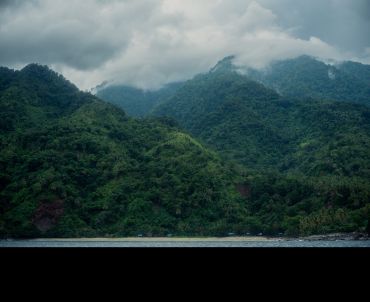 The Cyclops mountains as seen from the Pacific Ocean. Credit: Expedition Cyclops.
The Cyclops mountains as seen from the Pacific Ocean. Credit: Expedition Cyclops.‘Though some might describe the Cyclops as a “Green Hell”, I think the landscape is magical, at once enchanting and dangerous, like something out of a Tolkien book’ said Dr Kempton. ‘In this environment, the camaraderie between the expedition members was fantastic, with everyone helping to keep up morale. In the evening, we exchanged stories around the fire, all the while surrounded by the hoots and peeps of frogs.’
An enduring legacy
Tropical rainforests are among the most important and most threatened terrestrial ecosystems. It is our duty to support our colleagues on the frontline through exchanging knowledge, skills, and equipment.
Dr Leonidas-Romanos Davranoglou, Oxford University Museum of Natural History
Rediscovering the echidna is only the beginning of the expedition's mission. Attenborough's long-beaked echidna is the flagship animal of the Cyclops Mountains and a symbol of its extraordinary biodiversity. The team hope that its rediscovery will help bring attention to the conservation needs of the Cyclops, and Indonesian New Guinea more generally, and they are committed to supporting long-term monitoring of the echidna. Key to this work is NGO YAPPENDA, whose mission is to protect the natural environment of Indonesian New Guinea through empowerment of Indigenous Papuans. As part of the expedition team, members of YAPPENDA helped train six students from UNCEN in biodiversity surveys and camera trapping during the expedition.
With the team having only sorted a fraction of the material collected on the expedition, they expect that the coming months will yield even more new species. The intention is to name many of these after the Papuan members of the expedition.
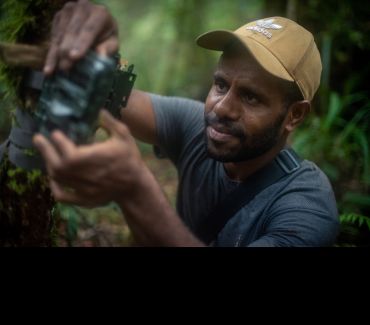 Cenderawasih University (UNCEN) student and team member Gison Morib setting up one of the eighty camera traps. Credit: Expedition Cyclops.
Cenderawasih University (UNCEN) student and team member Gison Morib setting up one of the eighty camera traps. Credit: Expedition Cyclops.More information can be found on the expedition website.
Academics who collaborated closely on the expedition include Dr James Kempton (University of Oxford), Dr Leonidas-Romanos Davranoglou (Oxford University Museum of Natural History), Madeleine Foote (University of Oxford), Dr Andrew Tilker (Re:wild, Leibniz Institute for Zoo and Wildlife Research), Dr Attila Balázs (Mendel University) and Dr Max Webb (Royal Holloway, University of London). Cenderawasih University (UNCEN) team members and partners include Dr Suriani Surbakti, Gison Morib and Heron Yando. Team members and collaborators from Indonesian NGO Yayasan Pelayanan Papua Nenda (YAPPENDA) include co-founders Iain and Malcolm Kobak, and Yali Kobak, Sampari Kobak, Ezra Daniel, Ruben Penggu, Melias Heluka, Yuanis Yalak and Sili Yalak.
 New study finds that stopping weight-loss drugs is linked to faster regain than ending diet programmes
New study finds that stopping weight-loss drugs is linked to faster regain than ending diet programmes